Weaving has been a constant in my life for 32 years now. I first learned to weave in college, while pursuing a degree in Design from U.C. Davis. In the beginning, I created vibrant, but more traditional, handwovens. Through my study of textiles at Davis, I fell in love with ikat fabrics and the random quality of their blurred edges. I was fascinated by the spontaneity of the dye process, the alchemy of mordants, and the layering of colors. There was no weaving program at Davis during my tenure, but they did have a weaving studio. One summer school weaving class later, and I found myself doing an independent study project on the ikat technique, where groups of yarn are bound in specific patterns, resisting the dye in certain areas.
Plastic ikat tape is used to bind bundles of warp yarns in order to resist the dyes. The brightly colored rolls of shimmery plastic tape sat on the shelves of the UCD weaving studio, beckoning me to experiment with them. To this day, I still feel a twinge of guilt, having used a whole roll of pricey clear plastic ikat tape as weft for one of my projects. However mischievous, that experimentation foreshadowed the kind of weaving I do with linear plastic elements today.
Coming from a long line of pack rats and flea market treasure hunters, it is a circumstance of heredity that predisposes me to rummaging through other people’s things. Mornings spent at yard sales with my mother, trips to the dump with my dad, and long, sweltering afternoons at the local swap meet with the whole family sealed my fate. Many collections fill my home, including buttons, sock monkeys, ethnic textiles, and vintage aprons. It’s reasonable to assume that my interests in textiles and fashion would merge with my obsession for collecting, and the result is my current body of work utilizing found objects and recycled materials.
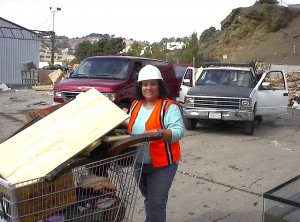
Sandy scavenging at the dump
For 3 months in 2004, from August through October, I had the providential opportunity to be part of Recology’s innovative Artist in Residence program headquartered at the San Francisco dump. They choose a select number of Bay Area artists each year to participate in their unique program dedicated to promoting awareness of recycling and resource conservation through the creation of artwork. All artwork is made on site using only materials scavenged from the dump. Artists receive a stipend, 24-hour access to a well-equipped studio, and free publicity. Recology keeps a few of the art pieces produced during the residency for their permanent collection. At the close of an artist’s tenure, the studio is converted into a gallery space, and an opening reception is held. Most importantly, artists get to draw from the tons of refuse that pass through the transfer station daily. Imagine getting paid to make art from trash!

San Francisco Dump
The waste stream is deep and wide, but for someone with an artistic eye, it provides an incredible treasure trove of materials. An art residence at Recology is like no other, and the opportunity to collect discards from such a target-rich environment was nothing less than intoxicating. The sheer volume of pure garbage is overwhelming, but understandable at the dump. More upsetting to me was bearing witness to the mountains of perfectly useable items tossed away without consideration.
The daily ritual of suiting up in a day-glow vest, hard-hat, steel-toed boots, dust mask, and heavy gloves was like preparing for an extraordinary quest. Scavenging the junk heap for treasure is physically taxing, and it’s important that you remain alert. Your finds have to be corralled quickly, because the bulldozer lies in wait to crush everything left behind. I filled shopping carts with heaps of raw materials, but many precious items also slipped through my fingers. The most difficult thing for me to find was proper warp yarn. The dump is full of half-finished acrylic yarn projects, but natural fibers were hard to come by. The woven fabrics I create now have more in common with the trash heap than with the yarn store. I weave cloth using a diverse assortment of recycled elements such as: plastic bags, caution tape, cornhusks, and inner tubes. Ordinary household items such as shower curtains, basketballs, rubber gloves, kitchen sponges, hair curlers, and zippers are repurposed and pressed into service as ingredients for construction in my artwear garments.
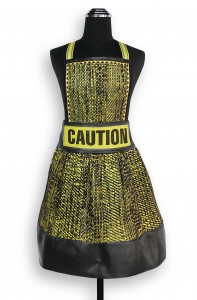
“Caution” 2004 made with caution tape, yarn, rubber tire inner tube, nylon webbing, leather, ribbon
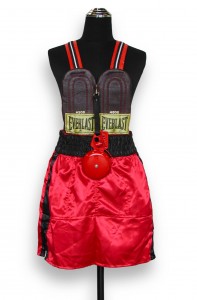
“Knockout” 2004Boxing shorts, leather boxing gloves,nylon webbing, leather rim, metal doorbell
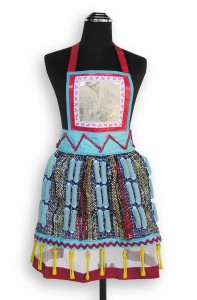
“Home Permanent” 2004 -made with plastic bags, fabric selvedge, hair curlers, permanent rods, photo image, yarn, rickrack, curtain trim, nylon webbing, wire
The one-of-a-kind garments I create include evening gowns and wedding dresses, but I especially enjoy adding embellishments to a frilly apron. Aprons protect our clothes and guard against spills. Aprons conjure up images of nostalgia, femininity, and the comfort of home. The apron is one of my favorite garment forms, as it has special significance as a symbol of women’s work. An icon of home and hearth, the apron can also be representative of women’s oppression. I use the apron as a template or canvas on which to project current issues or just to poke fun at popular culture. To me, aprons represent a woman’s strength and empowerment in the struggle. For the past few years, I have been producing a series of theme-based aprons that are both functional and symbolic. The intricate creations make reference to perceived notions of women’s work, delivered with a touch of humor and whimsy.
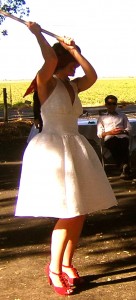
Wedding Dress 2009 for Cara Cordoni
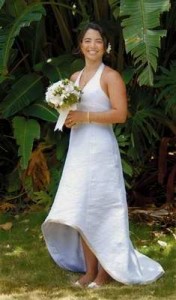
Wedding Dress 2008 for Celine Germain
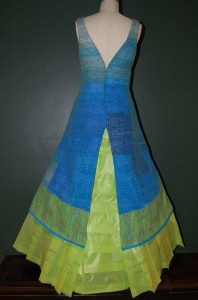
Back view of Evening News Dress for the front view, go to Memories 2014
The humble, yet ubiquitous, plastic shopping bag has been my inspirational muse for the past decade. This seemingly useless object, so easily discarded, can be transformed, through weaving, into a vibrant piece of cloth. Around 2002, I began weaving with plastic bags in an attempt to call attention to the needless waste perpetuated by their existence. I am simultaneously attracted to and repelled by those slick, supple, colorfully patterned bags. Here in the Bay Area, a willing majority of consumers now brings reusable bags with them when they shop. Even though I miss the fancy shopping bags that are no longer allowed in most municipalities, I am happy to see the progress we have all made towards reducing the number of plastic bags that will end up in our landfills and our oceans.
Although it’s been 10 years since my stint as Artist in Residence at Recology, the fond memories of the experience are still fresh in my mind, and I would do it all again in a heartbeat. More than 100 artists have participated in Recology’s AIR program since 1990, and together we form a kind of scavenger’s fraternity. In 2006, I participated in a second art residence, at St. Vincent de Paul of Alameda County, modeled on the one at Recology.
In 2007, I was commissioned by Recology to design an evening dress for then AIR assistant, Deborah Munk to wear onstage at the Herbst Theater in San Francisco. The fabric for the dress was hand woven using the rectangular plastic bags that wrap around the New York Times and San Francisco Chronicle newspapers. Bags were cut by hand, spiral-fashion, into long strips about ½ inch wide that were used as weft. Shades of green and blue were carefully arranged in the weft to create an ombre effect with gradations of color. Any CNCH members who attended the 2014 conference fashion show would have seen my “Evening News” dress modeled elegantly on the catwalk by Autumn Glock. The creation of this gown led directly to 2 more commissions, this time for wedding dresses requested by brides who had either “green” or DIY ceremonies. One wedding was on the beach, and the other on a farm.
I currently rent a studio space at Redux in Alameda, and I continue to explore new avenues in repurposing and reuse. I always try to inject a bit of humor into my art, using traditional needlework techniques in unexpected ways. I have been an active member of Golden Gate Weaver’s Guild since 1987. Fellow guild member Susie Hodges offers this quote, “Sandy’s aprons and gowns exist at the nexus of art and craft. She adds value, stability and new meaning to humble materials. To me, her beautifully made pieces hold a thoughtful social significance”.
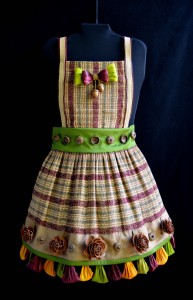
“Farm Fresh” 2013
handwoven fabric of yarn and long grasses. Embellished with hand dyed corn husk bows, acorn tops and pine cone rosettes
One of the main objectives of my artwork is to educate. When people are able to see items reused in unique and artistic ways, they may come up with innovative methods of dealing with their own discards, and they might think twice before throwing away anything useable. As an elementary school art teacher, I try to instill in my students the value of resourceful reuse and recycling, letting them see how imagination can turn discards into meaningful objects. They learn, as I have, to look at the garbage pile as a new source of artistic materials and endless possibilities.
Click here for the next article